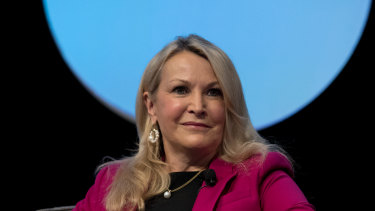[ad_1]
Good 12 months: Tech and Purchase Now, Pay Later
A rollercoaster 12 months for Australian tech shares was finally a narrative of extraordinary success and development. The sector took a beating identical to every other throughout the March selloff however was among the many quickest to rebound as lockdowns and journey bans saved Australians house and compelled them on-line for work, buying, and even primary dialog.
The native tech contingent has a market cap of about $90 billion – rating because the ninth-largest ASX 200 sectors – that means it might not have boosted the broader bourse in the identical manner that US giants Apple, Microsoft, Amazon, Google and Fb did for the NASDAQ or Wall Avenue.
However, at the same time as costs wilt amid a late-year rotation again into worth shares, the sector’s close to 40 per cent collective acquire made it a 12 months to recollect.

Co-founders Anthony Eisen and Nick Molnar floating the corporate in 2016. The shares first listed at $1.Credit score:
The plain star of the index was Nick Molnar and Anthony Eisen’s purchase now, pay later darling Afterpay. At its peak the $34 billion firm greater than tripled in worth from the place it began the 12 months, weathering regulatory scrutiny because it grew its share value above $120 on an increasing international footprint and a stream of analyst upgrades.
Not unhealthy contemplating its shares had been value simply $8.01 on the ground of the market in March.
Rival fee platforms had been additionally buoyant. Zip Co – technically a monetary agency – had additionally tripled in worth at its August peak of $10.64 and in September was included within the ASX 200. Outdoors the benchmark index, church-focused Pushpay greater than doubled its share value, Sezzle quintupled to a excessive of $11.83, and Splitit’s peak represented a rise of about 200 per cent.
There was additionally pleasure for a number of the larger tech companies. Machine studying and AI firm Appen elevated its share value by as a lot as 94 per cent, whereas accounting software program agency Xero grew by greater than 90 per cent to spice up its market cap above $21 billion. Knowledge centre operator NEXTDC trumped each, greater than doubling its worth because it hit a 2020 peak of $14.10 in early November.
Blended 12 months: Journey and airports
Australians confronted a battle to move right down to the nook store, not to mention journey to lands afar, so it’s no shock that among the heftiest declines hit companies that depend on individuals coming in and in a foreign country. State border closures additionally introduced the world’s second-busiest home route – Melbourne to Sydney – to a standstill.
Loading
Authorities-imposed border restrictions and worldwide journey bans might have helped cease the unfold of the virus, however the ensuing financial scars have been deep and extensive for our listed airways, airports, and journey brokers.
For a lot of, the cashflow dried up on day one and was adopted by tens of 1000’s of layoffs, plummeting share costs, and a swathe of capital raisings simply to remain afloat.
Tourism-focused companies equivalent to Flight Centre and Webjet had been significantly onerous hit.
A dose of vaccine optimism has since given the pair a year-ending tailwind however, as of early December, each had been nonetheless effectively down for 2020 and much underperforming the likes of business-focused agency Company Journey Administration.
The pandemic melted visitors at Sydney Airport and Auckland Worldwide Airport and each firms stay effectively within the crimson on the finish of the 12 months regardless of the prospect of home flights ramping up. Each accomplished capital raisings of $2 billion and $1 billion respectively.
Nationwide provider Qantas additionally endured its share of ache, taking a knife to its workforce and fleet to stem the income bleed and tapping shareholders for $1.9 billion.
Good 12 months: Digital and homeware E-tailers
On-line electronics and homewares had been among the many standouts of the pandemic’s 2020 retail revolution as lockdowns modified the way in which we store, and what we shopped for.
With much less money wanted for journey, transport, or hospitality, Australians as a substitute spent massive to arrange their house workplaces and deck their houses with creature comforts befitting a quarantine bunker.
Whereas a swathe of outlets was clearly left scarred by the shutdown of the financial system, for a choose few, the stimulus-fuelled work-from-home revolution lifted gross sales to file highs.
Share costs for acquainted names equivalent to JB Hello-Fi, Adairs, Nick Scali and Breville loved a surge in income – even with storefronts closed throughout the nation – whereas pure-play on-line companies equivalent to Kogan, Redbubble, and Temple and Webster lit up the All Ords.
Retail good points additionally rolled into the storage, with ARB Corp hitting file highs of $33.83 and paying out a hefty dividend on pent-up demand for four-wheel drive elements.
Of all the approach to life modifications to return from the pandemic, the shift to on-line retail might effectively show an enduring one, even when analysts tip normalising client behaviour to pull on gross sales in 2021.
Good 12 months: Iron ore and gold
It has been mentioned that Australia as soon as rode on the sheep’s again to financial prosperity.
Today it’s clear we’re sitting on the shoulders of mining giants.
Iron ore stays the nation’s largest money-maker and the majority steel was once more a famous person for the native financial system in 2020. Sturdy demand from an infrastructure-focused China and provide points at export rival Brazil pushed costs to seven-year highs of above $US170 a tonne, delivering large good points for a swathe of ASX 200 supplies firms who, in response to buyers, have changed the banks as dividend heavyweights.
But it surely wasn’t international miners Rio Tinto and BHP who set the tempo in 2020.

Fortescue Metals chief government Elizabeth Gaines. The corporate has been one in all 2020′s market stars as hovering iron ore costs helped gasoline a doubling of its market valuation to $67.4 billion.Credit score:Janie Barrett
Mineral Sources and Fortescue Metals boasted a far superior share value efficiency, every surging to file highs.
Fortescue’s large 12 months noticed its market cap balloon above $65 billion as its shares moved above $23 in December’s iron ore surge. The bulk stake held by majority shareholder Andrew “Twiggy” Forrest was, at one level, value greater than $25 billion.
Gold prospectors additionally shone brightly – no less than for the primary 10 months of the 12 months – with the dear steel logging contemporary all-time highs above $US2050 an oz. at the beginning of August. Gold did lose its lustre within the remaining weeks of 2020 because it was caught between rising coronavirus numbers within the US and Europe and the supply of a vaccine, however there have been loads of highs hit earlier than then.
Saracen Minerals at one level had doubled in worth in what could possibly be its remaining 12 months as a standalone entity earlier than it completes a mooted $16 billion merger with Northern Star.
Ramelius Sources, Evolution, and Silver Lake Sources had been additionally sturdy gold performers, rising their share costs greater than 100 per cent at their peak.
South Australian-focussed OZ Minerals is one other miner that deserves a point out. The copper miner’s share value rose greater than 50 per cent at its October peak as South American outages boosted costs throughout the 12 months. Heightened prospects stay for the steel that’s utilized in most electronics, in addition to electrical autos.
Blended 12 months: Vitality gamers
An oil value conflict between Saudi Arabia and Russia bought the 12 months off to a rocky begin and issues solely bought worse for vitality companies as lockdowns and journey restrictions smashed international gasoline demand.
Oil costs tanked as quarantine measures saved planes grounded, automobiles in garages, and industrial outputs weak.

Buyers worry the demand restoration may stall.Credit score:Bloomberg
The oil provide glut pushed storage ranges to the brink. In April the worth of US crude turned damaging for the primary time in historical past when futures contract homeowners could not promote their paper and panicked they may really must take supply of the black sticky stuff.
Loading
Vaccine hopes and the related cyclical resurgence has lifted native oil and gasoline firms in the identical manner that it has lifted journey shares, although the ASX 200 vitality sector stays by far the toughest hit throughout the entire of 2020.
Woodside Petroleum, whose chief government Peter Coleman described situations in 2020 because the hardest in his 40-year profession, greater than halved in worth at its March nadir to a 16-year share value low of $14.93. Its $5 billion half-year loss in August got here after it introduced it could slash as much as $6 billion from the worth of its belongings, although the corporate’s underlying revenue beat expectations.
Papua New Guinean-focussed Oil Search and fellow gasoline big Santos had been among the many others to rely the price of tanking costs. Seashore Vitality, Origin Vitality, and Cooper Vitality had been equally ravaged.
Coal miners had been additionally within the doldrums as costs took a dive and investor consciousness and motion on local weather continued to strain the business. Whitehaven shares sagged to a four-year low of 83 cents in September – a drop of practically 70 per cent. The corporate has since recovered a little bit of floor however the $5.40 peak of July 2018 nonetheless appears a very long time in the past.
Good 12 months: Ventilators, rubber gloves
A grim actuality of the pandemic – and a boon for healthcare buyers – has been the surging want for ventilators and hospital gear.

Ansell says demand for medical fits and single-used examination gloves is hovering. Credit score:Getty
New Zealand-based medical system maker Fisher and Paykel was one of many key beneficiaries of this shift, with the agency’s revenue and share value hovering via the primary and second waves of COVID-19.
Shares within the $20 billion, dual-listed medtech rose greater than 65 per cent to hit a file excessive of $34.92 in July and moved again inside touching distance of that peak in November earlier than it too pale amid vaccine optimism.
Loading
US-based ResMed adopted an analogous path, taking a brand new all-time peak 3 times in 2020 because it responded to file demand for hospital {hardware} on the similar time that its sleep apnea gross sales took a success. Its ASX-listed shares had been as a lot as 42 per cent greater at its November peak of $30.08.
Rubber glove-maker Ansell was one other early star in a pandemic-stricken index as hygiene wants moved front-of-mind. The agency went on a run of file highs from Could to August earlier than peaking at $43.17 in November.
A wildcard within the ASX 200 well being sector was stem cell researcher and day-trader favorite Mesoblast. The agency at one level greater than doubled in worth to a six-year excessive of $5.70 because it made steps in the direction of gaining approval for its flagship remestemcel-L. Nonetheless, a sequence of unfavourable updates despatched the agency’s share value plummeting as a lot as 40 per cent in a single December session.
Blended 12 months: Landlords
It’s a reasonably easy equation: Pandemic retains individuals inside, shops keep empty, income dives, shops wrestle to pay hire, stand-off with landlord intensifies.
As soon as-bustling CBDs had been decreased to wastelands throughout quarantine and retail landlords – already coping with a shift to on-line commerce – had been among the many hardest hit. Lease collections plunged amid at-times hostile stand-offs with retail tenants. Some merely stopped paying hire. Others demanded new revenue-linked occupancy offers, or threatened to stroll away altogether.
Mall homeowners Neighborhood Centres and Scentre Group not solely booked billions in write-downs in opposition to their respective property portfolios but in addition needed to struggle onerous to shake the ‘bully boy landlord’ tag over their efforts to claw again hire.
Loading
The reopening rally has since helped retail REITs choose up from the March lows however, very similar to their European-focussed cousin Unibail-Rodamco-Westfield SE, the scars of 2020 are clear to see of their depressed share value efficiency.
However, industrial property titan Goodman Group rode the accelerating e-commerce financial system to greater than 12-year highs as retailers tailored their provide chains and demand for warehousing house surged.
At its peak in November, the agency had risen 50 per cent for the 12 months to $20.07, boasting a market cap of greater than $34 billion.
“The logistics and warehousing sectors globally are enjoying an vital position, offering important
infrastructure and enabling distribution of merchandise to the group,” chief government Greg Goodman instructed buyers on the agency’s AGM.
“COVID-19 and the related lockdowns have created new on-line customers, which can doubtless additional enhance e-commerce gross sales, which are forecast to develop at over 25 per cent in 2020. This in flip can even drive the necessity for extra information storage.”
Enterprise Briefing
Begin the day with main tales, unique protection and knowledgeable opinion from our main enterprise journalists delivered to your inbox. Join the Herald‘s here and The Age‘s here.
Markets reporter for the SMH and The Age
Most Considered in Enterprise
Loading
[ad_2]
Source link

